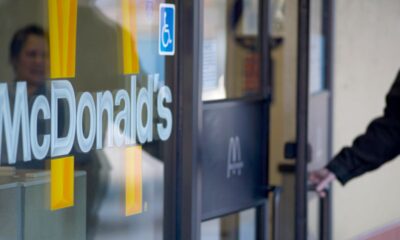Miami, FL
Lionel Messi’s ankle injury improves. Will he play Inter Miami’s next Leagues Cup game?

Lionel Messi continues to recover from his right ankle ligament injury, but he won’t play in Inter Miami’s Leagues Cup tournament match against LIGA MX club Tigres UANL on Saturday at Houston’s NRG Stadium.
Messi is out of the walking boot he used to begin his recovery, Inter Miami coach Tata Martino said during a news conference Friday. But Messi continues to work with team trainers and has yet to hit the field with his teammates in a practice setting.
Still, it’s a positive Messi injury update since he first suffered the injury during the Copa America final July 14.
Inter Miami’s match against Tigres UANL will determine seeding in the Leagues Cup tournament as both clubs have already clinched a spot in the Round of 32, beating Puebla during the group stage.
Inter Miami will face either MLS counterpart Toronto or LIGA MX side Pachuca in the knockout stage next week. If Inter Miami wins, it will face the Toronto-Pachuca loser. If Inter Miami loses, it will face the winner.
Despite already advancing to the knockout stage, Martino believes Tigres UANL could advance deep in the Leagues Cup, and Saturday’s match will serve as another measuring stick for Inter Miami. The club has won seven of eight matches without Messi since June 1.
“It is one of the most important teams in the [tournament], and it will surely be a nice test for us to see how we are to transcend in this competition,” Martino said of Tigres UANL.
The Inter Miami match against Tigres UANL begins at 8 p.m. ET (9 p.m. in Argentina) and will be live streamed by MLS Season Pass on Apple TV.
No, Messi is not expected to play in Inter Miami’s match vs. Tigres UANL during Leagues Cup.
All Leagues Cup games are available to live stream via MLS Season Pass on Apple TV.
Which MLS and LIGA MX teams have advanced in Leagues Cup?
As of Friday, 19 of 32 teams have already reached the knockout stage – 13 from MLS and six from LIGA MX.
∎MLS: Austin FC, Columbus Crew, D.C. United, FC Cincinnati, Inter Miami CF, LAFC, LA Galaxy, New York City FC, Philadelphia Union, Portland Timbers, Sporting Kansas City, St. Louis City SC, Toronto FC.
∎LIGA MX: Club América, CF Pachuca, FC Juárez, Mazatlán FC, Tigres UANL, Toluca FC.
Which MLS and LIGA MX teams have been eliminated from Leagues Cup?
So far, only five clubs have been eliminated from the tournament
∎MLS: Chicago Fire FC, FC Dallas, New York Red Bulls.
∎LIGA MX: Club Puebla, Club Querétaro.
Upcoming Leagues Cup Schedule
The round of 32 will be decided after these Leagues Cup games Saturday, Sunday, Monday and Tuesday.
Saturday, Aug. 3
- Tigres UANL vs. Inter Miami CF at NRG Stadium, 8 p.m.
- CF Monterrey vs. Pumas UNAM at Q2 Stadium, 10 p.m. (Univision)
- Vancouver Whitecaps FC vs. Tijuana at BC Place, 10 p.m.
Sunday, Aug. 4
- Atlanta United vs. Santos Laguna at Mercedes-Benz Stadium, 4 p.m.
- Orlando City SC vs. San Luis at INTER&Co Stadium, 8 p.m.
- Pachuca vs. Toronto FC at BMO Field, 8 p.m.
- Philadelphia Union vs. Cruz Azul at Subaru Park, 8 p.m. (FS1, UniMás)
- St. Louis City SC vs. Juárez at CITYPARK, 9 p.m.
- Chivas Guadalajara vs. LA Galaxy at Dignity Health Sports Park, 10:30 p.m.
- Seattle Sounders FC vs. Necaxa at Lumen Field, 10:30 p.m.
Monday, Aug. 5
- FC Cincinnati vs. New York City FC at TQL Stadium, 8 p.m.
- Houston Dynamo FC vs. Real Salt Lake at Shell Energy Stadium, 9 p.m.
- Club León vs. Colorado Rapids at Dick’s Sporting Goods Park, 9 p.m.
- Toluca vs. Sporting Kansas City at Children’s Mercy Park, 9 p.m. (FS1, UniMás)
Tuesday, Aug. 6
- New England Revolution vs. Nashville SC at Gillette Stadium, 7:30 p.m.
What is Leagues Cup tournament?
Leagues Cup is a 47-team World Cup-style tournament, featuring MLS teams from the United States and Canada, and LIGA MX clubs from Mexico. Inter Miami won the inaugural Leagues Cup behind Messi last year.

Miami, FL
Miami Heat-Minnesota Timberwolves Final Injury Update: Anthony Edwards’ status divulged

The Minnesota Timberwolves announced that guard Anthony Edwards is now available to play in Tuesday night’s game against the Miami Heat after originally being listed as questionable with right foot injury maintenance.
Here’s the rest of the injury report and game preview:
INJURY REPORT
HEAT
Tyler Herro: Available – Toe
Jaime Jaquez Jr.: Out – Ankle
Nikola Jovic: Available – Groin
Terry Rozier: Out – Not with team
TIMBERWOLVES
Anthony Edwards: Available – Foot
Terrence Shannon Jr.: Out – Foot
Joan Beringer: Out – G League
Game date, time and location: Tuesday, Jan. 6, 8:00 p.m. EST, Target Center, Minneapolis, Minnesota
TV: TV: Peacock,
Radio: 104.3 FM (Miami/Ft. Lauderdale), ESPN 106.3 FM, (West Palm Beach), FOX Sports Radio 105.9 FM (Ft. Myers/Naples), 1450 AM (Suart), 97.7 FM (Florida Keys), WAQI 710 AM (Spanish-language broadcast, South Florida) 100.3 FM (Minnesota)
VITALS: The Miami Heat (20-16) and Minnesota Timberwolves (23-13) meet for the second and final regular season matchup after just facing off three days ago with Minnesota recording a, 125-115, win in Miami on January 3. The teams split the series, 1-1, last season with each squad winning on the road. The Heat are 36-35 all-time versus Minnesota during the regular season,
including 19-16 in home games and 17-19 in road games.
PROJECTED STARTERS
HEAT
G Davion Mitchell
G Tyler Herro
C Bam Adebayo
F Norman Powell
F Andrew Wiggins
TIMBERWOLVES
G Donte DiVincenzo
G Anthony Edwards
C Rudy Gobert
F Jaden McDaniels
F Julius Randle
Spread: Heat +5.5 (-112), Timberwolves -5.5 (-108)
Moneyline: Heat +166, Timberwolves -198
Total points scored: 239.5 (over -106, under -114)
QUOTABLE
Heat head coach Erik Spoelstra on the forced turnovers: “That is and has to be our identity. We have to play with a recklessness and activity level that exceeds our opponent, and thats not to put down our talent level or anything like that, it’s more about we look different when we’re flying around and making plays and making it tough for the opponent.”
For more Miami Heat information and conversation, check out Off The Floor.
Alexander Toledo is a contributor to Miami Heat On SI and producer/co-host of the Five on the Floor podcast, covering the Heat and NBA. He can be reached at Twitter: @tropicalblanket
Miami, FL
Man shot during $22,000 gold chain robbery at Supreme store in Miami’s Design District; Atlanta suspects arrested

Three men were arrested Saturday after a robbery inside a Miami clothing store left a man shot and hospitalized, according to Miami police and arrest affidavits.
The incident happened Friday afternoon in Miami’s popular Design District neighborhood.
Police said officers were dispatched around 4:20 p.m. Friday to the area of Miami Avenue and Northeast 41st Street after receiving reports of a man who had been shot. Officers found the victim, who told them he had been robbed and shot while shopping inside a Supreme store located at 45 NE 41st Street.
According to investigators, the victim said he was approached by three suspects inside the store, including one person with whom he had a prior conflict originating from the Atlanta area. Police said an argument broke out, and one suspect forcibly removed a gold chain from the victim’s neck. The chain was valued at approximately $22,000, according to police.
As the suspect ran out of the store, the victim attempted to chase him, police said. During the pursuit, an unidentified male shot the victim once in the stomach. The suspects then fled the area in a white Mercedes-Benz, according to the arrest affidavits.
Miami Police detectives later located the suspect vehicle parked near Northeast 10th Avenue and Northeast 91st Terrace. Police said they conducted surveillance and observed the suspects abandon the vehicle and walk through a nearby residential area before entering a home in the 800 block of Northeast 90th Street.
A residential search warrant was executed, resulting in the arrest of three suspects. During the search, detectives recovered the victim’s gold chain, keys to the suspect vehicle, and clothing believed to have been worn during the robbery, police said.
The suspects were identified as Jamar McKay, 25, Omarion Phillips, 20, and Kevieon Smith, 21. McKay was charged with armed robbery with a firearm or deadly weapon. Phillips and Smith were charged as accessories after the fact, with Smith also facing an additional firearms-related charge, according to court records.
“This arrest sends a clear message: violent crime will not be tolerated in the City of Miami,” Miami Police Chief Manuel Morales said in a statement. “Individuals who commit acts of violence in our city will be identified, located, and held fully accountable.”
Miami, FL
Miami Hurricanes arrive in Phoenix to continue Fiesta Bowl preparations
Miami Hurricanes arrive in Phoenix
Miami Hurricanes arrive in Phoenix on Jan. 5, 2026, ahead of their matchup with the Ole Miss Rebels at the 2026 Vrbo Fiesta Bowl.
The Miami Hurricanes are looking to buck a bad trend. They’re 0-4 in the Fiesta Bowl.
Coach Mario Cristobal’s team gets its fifth shot this week as Miami (12-2) squares off against Mississippi (13-1) in the Fiesta Bowl at 5:30 p.m. on Jan. 8 at State Farm Stadium. The school may be 0-4 historically, but there is plenty at stake. This Fiesta Bowl is serving as a College Football Playoff semifinal.
The Hurricanes, the No. 10 seed in the 12-team playoff field, arrived at 5 p.m. Monday, Jan. 5, at the Ragsdale Executive Terminal of Sky Harbor Airport. The opposing team is expected 24 hours later.
The gathered crowd of 100 or so was made of members of the Fiesta Bowl Committee, easily identifiable in their yellow jackets, and their families.
In the past, there had been a welcome event in a tent adjacent to the runway. The coach typically made an opening statement, but players and coaches walked off the plane and straight to their buses parked nearby.
Players, dressed in white sweatsuits, filed off their American Airlines flight in single file on a blue carpet.
The players will take part in a media day on Jan. 6 at a Scottsdale hotel, with the coaches talking to the media the following day, the eve of the contest.
The Hurricanes enter on the heels of a six-game winning streak. Their last loss came on Nov. 1 against SMU, a game decided in double overtime 26-20. They have surrendered just 17 points in their two postseason games.
The winner advances to the national championship game on Jan. 19 against the winner of the other semifinal, the Peach Bowl between Oregon and Indiana.
-

 News1 week ago
News1 week agoFor those who help the poor, 2025 goes down as a year of chaos
-

 Detroit, MI5 days ago
Detroit, MI5 days ago2 hospitalized after shooting on Lodge Freeway in Detroit
-

 Dallas, TX3 days ago
Dallas, TX3 days agoDefensive coordinator candidates who could improve Cowboys’ brutal secondary in 2026
-

 Southeast1 week ago
Southeast1 week agoMurder in small-town America: The crimes that tore quiet communities apart in 2025
-

 Technology2 days ago
Technology2 days agoPower bank feature creep is out of control
-

 Midwest1 week ago
Midwest1 week agoMcDonald’s locks doors to keep out individuals who present ‘a risk’ in crime-ridden Minneapolis area
-

 West1 week ago
West1 week agoApex predator threatening Northwest salmon sparks rare bipartisan push to ‘kill more’
-

 Southwest1 week ago
Southwest1 week agoMissing 19-year-old Camila Mendoza Olmos believed to be ‘in imminent danger,’ Texas sheriff says






















